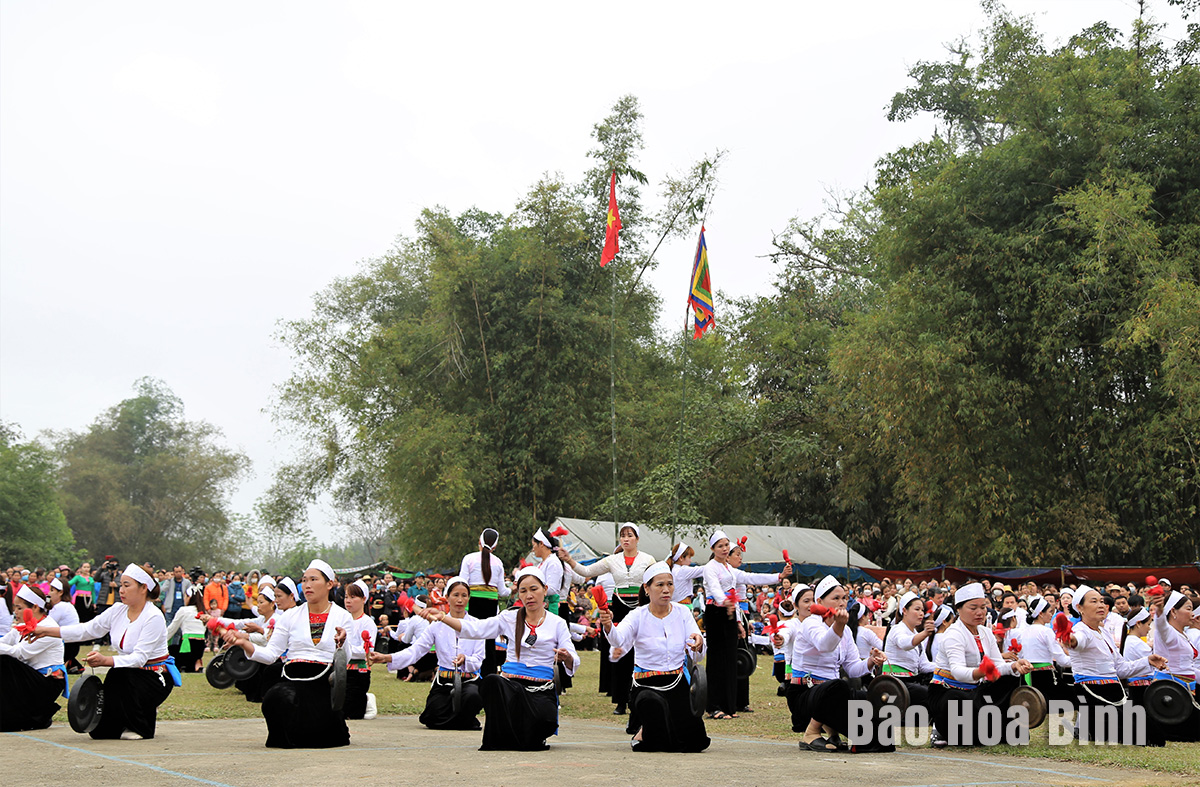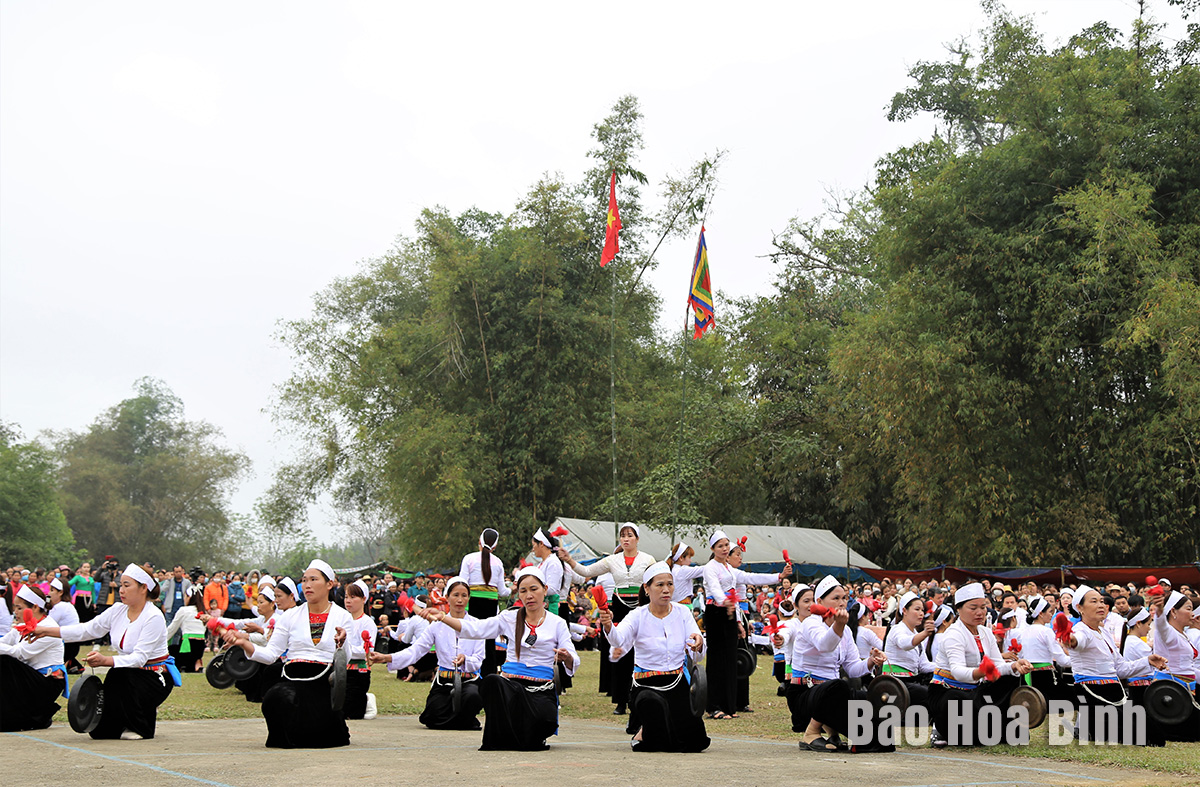
Hoa Binh, a gateway to the Northwestern region, is home to six main ethnic groups, namely Muong, Kinh, Tay, Thai, Dao and Mong, of whom the Muong people account for about 64%. In recent years, with the efforts of Party committees and administrations at all levels and ethnic minorities, the province has achieved encouraging results in preserving and promoting traditional cultural values.

Traditional festivals in the province are organised
to contribute to preserving and promoting the cultural identity of ethnic
groups. Photo taken at Ke Pagoda Festival in Phu Vinh commune (Tan Lac
district).
The preservation and promotion of the cultural heritage
values of the ethnic groups has been given special attention by Party
committees and administrations at all levels. The province has issued a lot of
directive documents, including Resolution No. 04-NQ/TU, dated October 11, 2021
of the provincial Party Committee’s Standing Board on preserving and promoting
the cultural heritage values of ethnic groups in Hoa Binh province for the 2021
– 2025 period, with a vision to 2030.
Quach Thi Kieu, Director of the provincial Department of
Culture, Sports and Tourism, said that the highlight of the work is that the
province has carried out a programme to conduct a general inventory of all intangible
cultural heritage of local ethnic groups. Up to now, the whole province has 786
intangible cultural heritage pieces, including: language, writing, folk
literature, folk performing arts, traditional crafts, social customs and
belief. It owns five national intangible cultural heritages: Mo Muong, Muong
Gong Art, Muong bamboo calendar folk knowledge, Khai Ha traditional festival of
Muong people, and Keng Loong social customs and the belief of Thai people in
Mai Chau district.
On September 8, 2016, the provincial People's Committee
issued Decision No. 2295/QD-UBND on approving the Muong handwritings of Hoa
Binh province. The provincial People's Committee issued Decision No.
1349/QD-UBND, dated June 8, 2019 approving a project on teaching and learning the
Muong ethnic language in the province for the 2018 – 2025 period, with a vision
to 2035. The Department of Education and Training has organised training
courses to build a contingent of experts to teach the Muong language.
In addition, implementing a project to preserve traditional
costumes of the ethnic groups, localities, agencies and units have had many
solutions to encourage officials, members and people to wear traditional
costumes on holidays and anniversaries, and encourage students to wear traditional
costumes in flag-raising ceremonies, and cultural and artistic activities.
Hoa Binh province has carried out multiple programmes and initiatives to revive its cultural heritage which has gradually fallen into oblivion through the ebbs and flows of history.
The most prominent and defining feature in the prehistoric era of Hoa Binh is the Hoa Binh Culture. The Culture was first discovered in Hoa Binh. The significant prehistoric culture represents not only Vietnam but also Southeast Asia and southern China. Through excavations of cave sites in the limestone regions of Hoa Binh, French archaeologist M. Colani introduced the world to a "Stone Age in Hoa Binh province – Northern Vietnam" in 1927. On January 30, 1932, the First Congress of Far Eastern Prehistorians, held in Hanoi, officially recognised the Hoa Binh Culture.
Known as the "Land of Epic History”, Hoa Binh province, the gateway to Vietnam’s northwest, boasts a strategic location and a unique cultural tapestry woven by its ethnic minority communities.
The People's Committee of Luong Son District recently held a ceremony to receive the certificate recognizing Sau Communal House in Thanh Cao Commune as a provincial-level historical and cultural site.
Recognising the importance of cultural heritage preservation in protecting and promoting the value system of Vietnamese culture, and serving socio-economic development in the new period, Party committees and local administrations in Hoa Binh province have identified it as a key task in the cultural development strategy. The province has been making efforts in mobilising resources, creating consensus among people and engaging ethnic communities in preserving and promoting cultural identity.
Hoa Binh province has captured growing attention both domestically and internationally for its distinctive cultural heritage and rich history. Most notably, it has been renowned for its famous Hoa Binh culture, considered the cradle of ancient Vietnamese civilisation. Looking ahead to significant milestones in 2025 and the 140th anniversary of province establishment in 2026, Hoa Binh Newspaper presents a comprehensive overview of the province's development across economic, social, cultural, tourism, and security domains.



